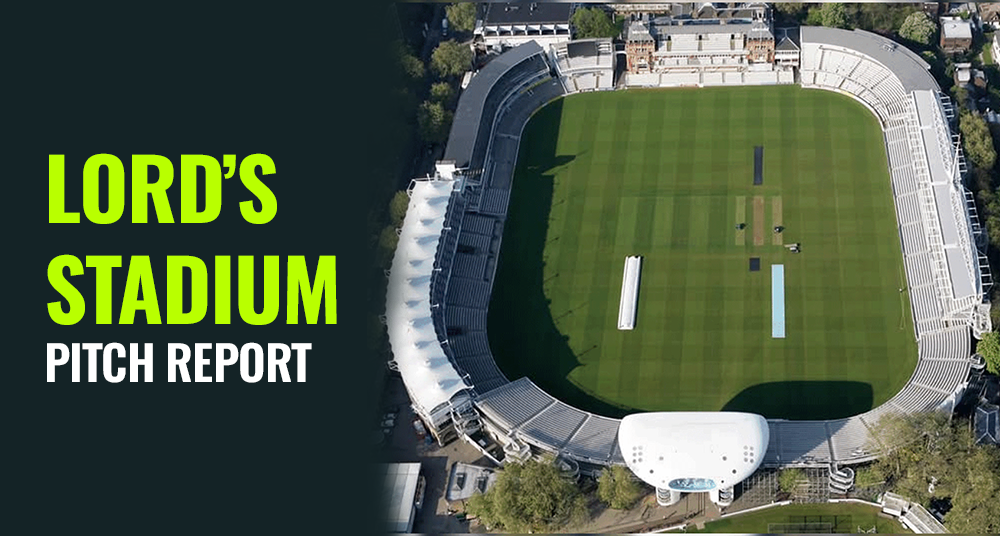Lord’s Cricket Ground in London is one of the most respected venues in the world of cricket. Known for its iconic slope and ever-changing conditions, Lord’s often surprises teams with its pitch behavior. The surface can help fast bowlers early on, especially if the weather is cloudy, but it usually becomes better for batting as the match goes on. Toss plays a key role here, and so does the unpredictable London weather. In this post, we’ll break down the current pitch conditions, toss trends, and weather forecast for today’s game at Lord’s.
Lord’s Cricket Ground: Legacy, Records, and Pitch Identity
Lord’s Cricket Ground in London is often called the “Home of Cricket”—and for good reason. Built in 1814, it’s one of the oldest and most respected stadiums in the game. From historic Ashes battles to unforgettable World Cup moments, Lord’s has seen it all. It can seat over 30,000 fans and has a unique slope across the field, which makes the pitch behave differently depending on which end you’re bowling from. Early in the match, fast bowlers usually get help thanks to the green surface and cloudy English weather. But as the game goes on, the pitch becomes better for batting. No matter the format—Test, ODI, or T20—playing at Lord’s is always a true test of skill and strategy.
| Aspect | Details |
| Location | London, England |
| Established | 1814 |
| Seating Capacity | ~30,000 |
| Famous For | Iconic slope, historical matches, Home of Cricket |
| Pitch Behavior | Early seam and swing; flattens out later |
| Average Test 1st Innings Score | ~310 |
| Unique Feature | 2.5-meter slope from Pavilion to Nursery End |
| Favors Early On | Fast bowlers, especially with overcast conditions |
| Batting Conditions | Improve from Day 2 onward (in Tests) |
| Notable Matches | 2019 WC Final, Historic Ashes Tests, Multiple India vs England encounters |
Lord’s Pitch Conditions Explained: Bowling and Batting Trends
The pitch at Lord’s is one of the most discussed surfaces in world cricket, thanks to its natural slope, greenish top early on, and the often overcast London weather. In the initial sessions of a match, seam and swing bowlers tend to dominate, with the ball moving off the surface and through the air. However, as the match progresses—especially in Tests—the pitch flattens out and becomes more suitable for batting. Spin doesn’t play a major role here unless it’s the fifth day of a Test or the pitch is unusually dry. Here’s a breakdown of how the Lord’s pitch typically behaves across formats and match days:
| Match Format / Day | Pitch Behavior | Favours |
| Test – Day 1 | Fresh grass, seam movement, swing in the air | Fast Bowlers |
| Test – Day 2 | Still helps seamers, and batting gets easier | Balanced |
| Test – Day 3 | Flatter surface, good for batting | Batters |
| Test – Day 4 | Drying pitch, consistent bounce | Batters, occasional reverse swing |
| Test – Day 5 | Wear and tear, variable bounce | Spinners (mild), all-rounders |
| ODI / T20 – 1st Inn | Early swing, slight seam | Bowlers (especially new ball) |
| ODI / T20 – 2nd Inn | Dew may come into play, ball skids nicely | Batters |
Toss Decisions at Lord’s: Key Trends and Winning Records
At Lord’s, the toss has a significant—but not overwhelming—impact on match outcomes. Historical Test data shows that out of 148 matches, teams batting first after winning the toss claimed victory 53 times, while those fielding first secured 44 wins, along with 51 draws This relatively even split underscores how dynamic the conditions are at Lord’s: captains must weigh the early assistance for seamers against the long-term benefits of batting on a flatter pitch. Analysis of India–England Tests reveals a similar pattern: batting-first teams have won 4 of 6, yet decisions to field first have delivered mixed results—winning 2, losing 2, and with 1 draw, Cricket Times. In short, the toss at Lord’s is a high-stakes gamble where context overrides pure numbers.
| Toss Decision | Times Chosen | Wins | Losses | Draws/RNR |
| Bat First (won toss) | 53 | 53 | – | Included above |
| Field First (won toss) | 32 | 16 | 14 | 1 draw, 1 NR |
| Lost Toss | 43 | 22 | 19 | 1 draw, 1 NR |
- Winning the toss gave teams a slight edge: ~36 % win rate vs ~29 % when losing
- Captains who opt to bowl first do so because early pitch moisture and slope can offer seam and swing, but it’s riskier if batting later becomes easier under hot and dry conditions.
Key Takeaways
- Bat-first is slightly safer historically, but the early green pitch can offera short-term advantage to seamers.
- Field-first is bolder—works best on days with overcast skies and seam-friendly grass.
- Match context matters: weather, recent pitch behavior, and team composition (e.g., pace-heavy attack) should guide decisions.
Recent Toss Decisions & Match Results at Lord’s (Tests)
| Match | Toss Winner | Decision | Match Result |
| IND vs ENG – 2021 | England | Bowl First | India won by 151 runs |
| ENG vs NZ – 2022 | England | Bowl First | England won by 5 wickets |
| ENG vs SA – 2022 | South Africa | Bat First | South Africa won by an innings & 12 runs |
| ENG vs IRE – 2023 | Ireland | Bat First | England won by 10 wickets |
| ENG vs IND – 2025 (3rd Test)* | TBD | TBD | Ongoing |
Insights:
- In 2021, England bowled first at Lord’s against India, expecting to use the swing-friendly conditions, but India batted smartly and dominated.
- In 2022, England flipped the script vs New Zealand: bowling first worked in their favor thanks to excellent conditions and aggressive bowling.
- The results show that bowling first can work if conditions are favorable, but batting first remains a safer, more consistent choice at Lord’s.
Average Scores at Lord’s: Format-Wise Match Statistics
Understanding average scores at Lord’s Cricket Ground helps decode how the pitch plays across different formats. While Test matches at Lord’s tend to start with movement and settle into good batting conditions, ODIs and T20s at the venue offer a more balanced contest between bat and ball. Historically, scores above 300 in Tests and 270+ in ODIs are considered competitive. Here’s a breakdown of average innings totals at Lord’s to give you better clarity:
Key Takeaways:
- In Test matches, teams aim for 300+ in the first innings to set a strong foundation.
- The 4th innings become challenging due to pitch wear, bounce variation, and scoreboard pressure.
- In ODIs, a 275+ total is typically defendable, but chasing sides have had success too, especially with dew or a flat surface.
- T20Is at Lord’s are rare, but typical scores hover around the 160 mark.
Recent High-Profile Matches at Lord’s (2022–2025)
| Match | Outcome & Key Performance |
| SA vs AUS – 2023 WTC Final | 14 wickets fell each of the first two days—Pat Cummins’ 6/28 set the tone, testifying to early seam dominance. |
| India vs England – 2021 Test | India sealed victory after engineering England to field first; highlight – slope troubled batters (151-run win) . |
| England vs NZ – 2022 ODI | England posted a commanding win; seamers exploited green pitch early, but batters finished it off at 312‑211 chase . |
| India vs England – 2025 Edgbaston (Test #2)** | India clean-swept England with Akash Deep and Siraj dismantling the batting order; momentum arrived before the Lord’s clash. |
| ENG vs IND – 2025 3rd Test Build-up | Pitch expected to be lively at Lord’s; slope highlighted as a hidden weapon for seamers and fast bowlers. |
Final Words
Lord’s Cricket Ground remains one of the most tactically complex venues in world cricket. From its iconic slope to its unpredictable weather and pitch behavior, every match played here offers a unique challenge for players and captains alike. Early movement with the new ball, gradually easing batting conditions, and the toss often becoming a game-changer—these elements make Lord’s a true test of skill, patience, and adaptability.
Whether you’re analyzing fantasy cricket, following your favorite team, or just a cricket enthusiast, understanding how the Lord’s pitch evolves across days and formats gives you the edge. As always at Lord’s, expect the unexpected—because history is never far away from being rewritten here.
FAQs on Lord’s Cricket Ground Pitch Report
Q1. How does the pitch at Lord’s usually behave?
A: The Lord’s pitch typically offers swing and seam movement early in the match due to grass and weather. As the game progresses, it becomes flatter and better for batting.
Q2. Is Lord’s a batting or bowling-friendly pitch?
A: It’s generally balanced. Early conditions favor fast bowlers, especially under overcast skies. Later, batters enjoy consistent bounce and scoring becomes easier.
Q3. What role does the slope at Lord’s play?
A: Lord’s has a unique 2.5-meter slope that affects the bounce and movement of the ball. It can make life tricky for batters and give an edge to skilled bowlers.
Q4. Is winning the toss important at Lord’s?
A: Yes. Captains often prefer to bowl first if the conditions are cloudy, but batting first can also pay off if the pitch flattens later. Toss decisions depend heavily on weather and pitch moisture.
Q5. What is the average score in Tests at Lord’s?
A: The average first innings score in Tests at Lord’s is around 310. The pitch tends to slow down by Day 4 or 5.
Q6. Do spinners get help at Lord’s?
A: Not usually. Lord’s is more known for favoring seamers, though spinners can come into play on Day 5 of a Test match when the pitch starts to wear.
Q7. How is the weather at Lord’s during matches?
A: London’s weather can be unpredictable. Overcast skies are common and can aid swing bowling, while sunny days tend to favor batting.
Q8. Is Lord’s pitch different for ODIs and T20s?
A: Yes. In limited-overs formats, the pitch is often flatter with less movement, but the new ball still offers some swing early on.



